The most popular houseplant in the world, pothos are easy to find, easy to grow, and easy to enjoy. With so many choices, whichever of these pothos types that you prefer will make an attractive plant for your home or office.
In fact, whatever your decor needs are, keep reading to find out all about the different varieties of pothos out there to take your pick!

Table of Contents
Pothos types
With pretty, glossy leaves that feature various color patterns and shapes, the pothos plant is one of the most familiar houseplants around. All types of Pothos plants are not only beautiful, but they have plenty of other benefits, regardless of the variety that you choose.
Pothos plants are very easy to grow, making them an excellent choice for novice plant owners, and they manage well on benign neglect. You don’t have to water your pothos more than three or four times a month, and they do not need lots of sunlight, thriving in indirect sun indoors.
There are over 20 different varieties of pothos plants in the world, although some of the varieties feature different names. They are all easy to grow, although some cultivars are easier to find in stores than others. New pothos varieties are being developed all the time.
If you care for your pothos plant correctly, it will stay healthy and beautiful for years. It seldom has pests or diseases if you take care of the plants correctly. Just a bit of basic plant knowledge is enough to keep this plant thriving in your home.
One thing to keep in mind is that all varieties of pothos plants are toxic to dogs, cats, other pets and small children, so you should keep them put away, out of reach of these special family members.
1. Snow Queen Pothos
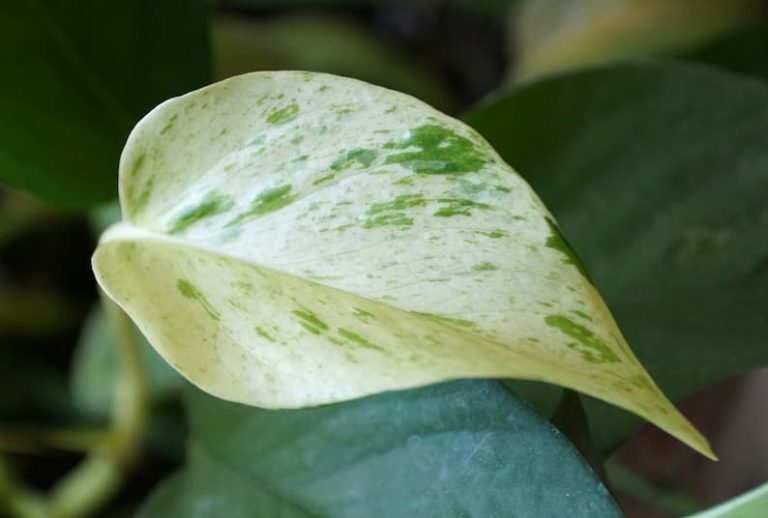
Snow Queen pothos were named for the snow-covered hillsides of their native Southeast Asia. Sometimes called Snow Ivory, Snow Fairy, or Snow Princess, these pothos plants feature pure white streaks on their green foliage. The appearance is such that the plant is covered with snowy patches.
To keep its variegation, the Snow Queen pothos needs the correct light levels, which consist of 4 to 6 hours per day of indirect sunlight. If the plant receives too much sunlight, it will suffer from sunburn, which looks like yellowing, wilted leaves. If the plant receives too little sunlight, its variegation will fade and the classic white patches will grow smaller and smaller.
2. Golden Pothos

Sometimes called Devil’s Ivy, the Golden Pothos plant has heart-shaped, glossy leaves marked by unusual color splotches of cheerful yellow. Like most pothos plants, the Golden Pothos is an easy-care plant that thrives on benign neglect. While the plant will do best when watered and tended faithfully, it will still grow fairly well when it is only watered when wilted.
One amazing thing about the Golden Pothos plant is that NASA includes it on the list of plants recommended for air purification. Most people’s homes are full of toxic chemicals due to the soup of carpet chemicals, paint gasses, and other contaminants present in most modern construction. Growing a Golden Pothos plant can purify the air in your home, since it absorbs these chemicals and releases clean, pure oxygen into the environment.
3. Jessenia Pothos
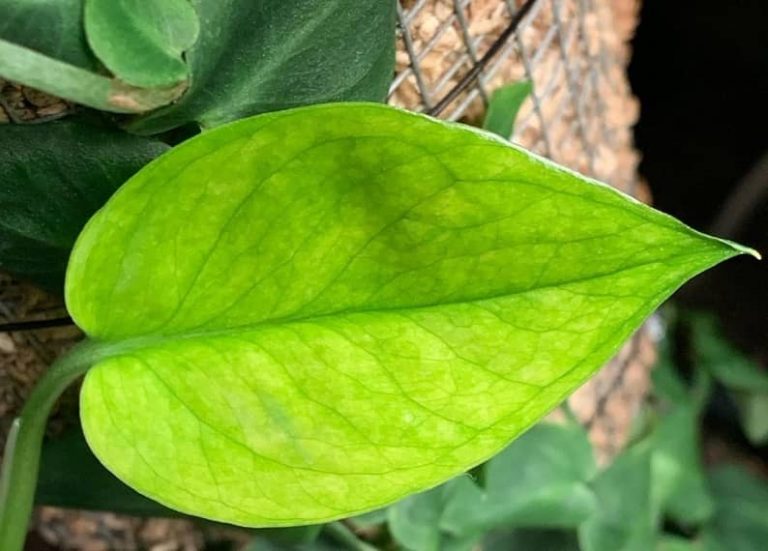
A fairly new cultivar of the pothos plant, the Jessenia version of this lovely plant features brilliant chartreuse heart-shaped leaves speckled with darker green blotches. These plants do need indirect sunlight, but too little sunlight may cause the distinctive variegation to fade. Be sure that your Jessenia pothos has 4 to 6 hours of indirect sunlight per day.
Jessenia pothos is similar to Marble Queen pothos in that it has tiny flecks of color patterns and no large blotches of solid coloring. Jessenia pothos plants should have no yellow or white colors on the plant, but only light green and dark green coloration. Jessenia pothos plants have an understated, subtle beauty that true plant lovers will greatly appreciate.
4. Cebu Blue Pothos

Named for the Philippine island on which it grows in the wild, the Cebu Blue pothos is an uncommon pothos plant known for its thin, silvery blue leaves. The heart shaped leaves are long and narrow, quite distinctive from other pothos leaves.
Young Cebu Blue pothos grow well as a potted plant, but as a mature plant, these pothos plants are incredible climbers, growing up a moss pole or on a trellis.
The Cebu Blue pothos has two separate growing phases. Juvenile Cebu Blue pothos plants are the most common, and during this growth phase, the plant develops the classic silver-blue leaves that are long and narrow. The mature phase generally only occurs in plants that are grown outdoors, and during this phase, the plant grows larger green leaves with openings in the leaves called fenestrations.
5. Hawaiian Pothos
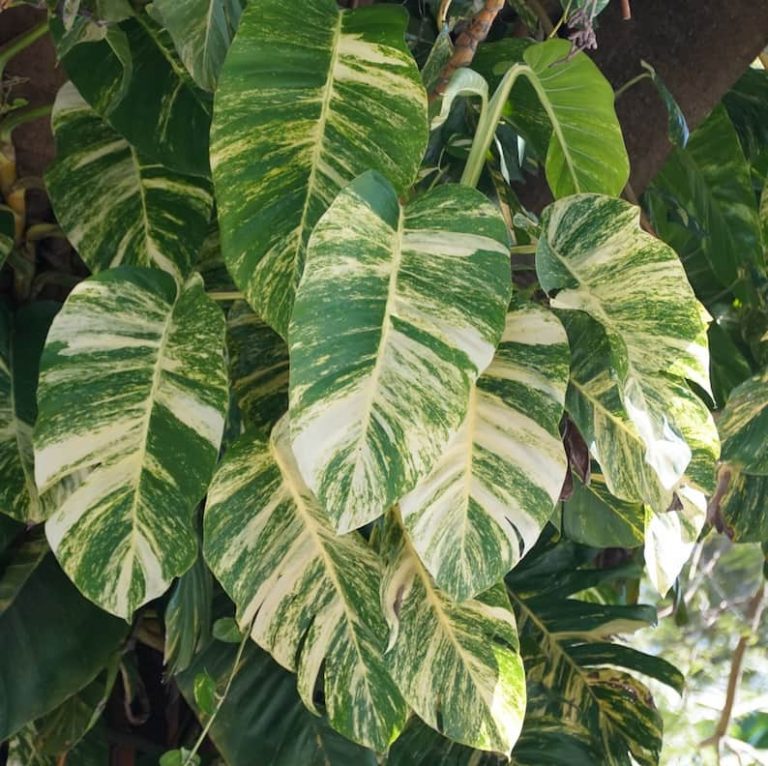
A more rare pothos plant, the Hawaiian pothos has eye-catching glossy leaves that feature bands of green and gold. The Hawaiian pothos is unusual in that when it grows into a mature plant, the leaves will grow quite large, from 5 to 12 inches long. The Hawaiian pothos is flashy and attractive with lots of variegation on the leaves.
While Hawaiian pothos plants do rather well in low light conditions, if they do not have adequate light the flashy color patterns will begin to fade and the solid green will start to take over. This happens because the green areas generate food for the plant and if there is not enough sunlight to provide enough nourishment for the plant, the plant will adapt to the light conditions by taking over the yellowed areas and making them green.
6. Harlequin Pothos
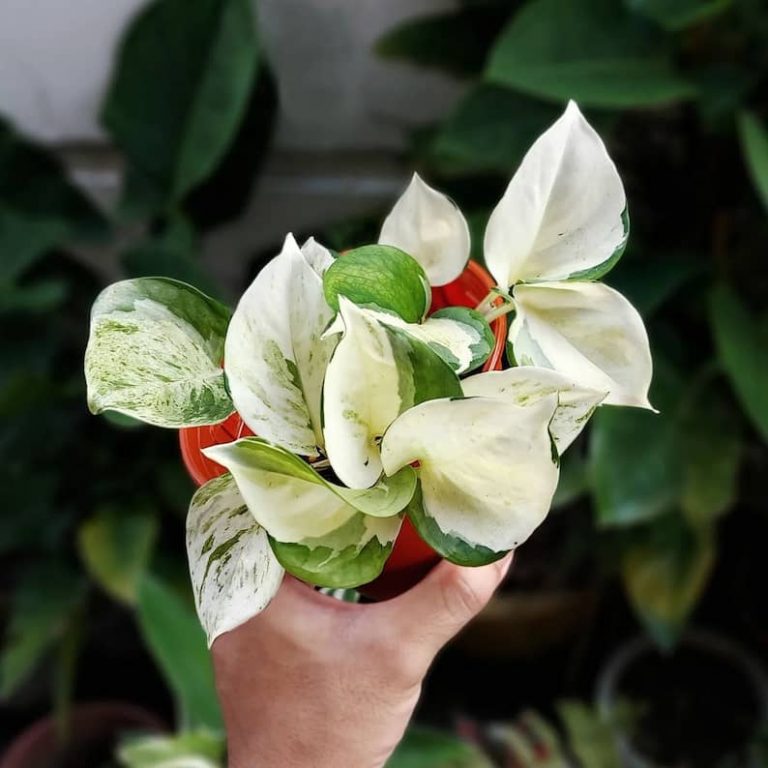
Harlequin pothos are stunningly beautiful pothos plants that are very rare. Harlequin pothos are quite similar to Manjula pothos in that they both have large flashy patches of white variegation on the leaves. However, Harlequin pothos plants only have green and white, while Manjula pothos has white, neon green, and light green on the plants.
The Harlequin pothos plant can be incredibly difficult to find. If you do find this exotic and beautiful plant, it will likely be very expensive. You may not find it in typical stores and garden centers, and you probably will have to buy from a specialty online retailer to obtain the Harlequin pothos plant.
7. Silver Pothos
Originating in Southeast Asia, the Silver Pothos plant has heart shaped leaves that are dark green. The plant’s leaves also have gorgeous silver gray splotches on them which add to the interest and drama of this lovely houseplant. Generally, the outer rim of the plant is lined with silver-gray, accentuating the heart shape of the leaves.
Silver pothos is a cousin of the typical pothos plant, being of the species Scindapsus pictus. Typically, pothos, such as the Golden pothos, Hawaiian pothos, or Jessenia pothos, are from the species Epipremnum aureum. Technically, however, all of these plants are from the Arum plant family and feature the same attractive foliage and easy care routine.
Find out more about this plant: 10 Causes of Silver Pothos Leaves Curling (and How to Fix It)
8. Satin Pothos

Satin pothos is simply another name for the Silver pothos plant. These plants have dark green leaves with silvery markings on the leaves, scattered in random blotches. The plants have an unusual satiny texture to the leaves, instead of the high-gloss sheen of the traditional pothos plant.
There are three main types of Satin pothos varying only in the silvery markings on the plant, and all of them make good houseplants, including if you wish to propagate Satin pothos. The “Argyraeus” version of the Satin pothos has sparse silver markings, and the “Exotica” version has splashes of silver on the leaves. The “Silver Ann” variety has mostly silver leaves, and to keep it healthy it will need somewhat more light than the less variegated versions of these plants.
Related: Silver Satin Pothos: The Ultimate Guide
9. Manjula Pothos
Manjula pothos plants originated in the United States and were created by botanists at the University of Florida. Manjula pothos plants have bright green, heart shaped leaves marked by large splotches of cream on the leaves. These plants are also known as the Happy Leaf pothos plant.
Manjula pothos plants can be rather difficult to find since they are considered to be rare. To find one, you may need to search at exotic plant shops or online retailers. However, despite its rare status, the Manjula pothos plant is as easy to care for as most other pothos plants.
10. Neon Pothos

One of the more unusual pothos plants, the Neon Pothos is bright, cheerful, and eye-catching. This pothos plant originated in places like Tahiti and Moorea and features chartreuse neon green leaves. The leaves of the Neon Pothos can grow very large and their bright color appeals to people with less traditional home decor tastes.
Although these plants are attractive and eye-catching, they do not have flowers or fragrance, making the Neon pothos a good choice for places that need a subtle touch to the decor, such as offices or other public spaces. The plants have low light needs, so if you work in a dim office or want a great bathroom plant, the Neon pothos might be just the perfect plant choice for you. In fact, if the plant gets too much sun, the leaves will begin to look pale, and the neon green color will fade a bit.
Are Neon Pothos and Golden Pothos the same?
No, the Neon Pothos and Golden Pothos are not the same plant. The main difference between them is the color of their leaves. Neon pothos sport leaves that are a single, bright chartreuse color, with no variegation. Golden pothos plants have leaves that are green with generous areas of bright yellow variegation.
Golden pothos plants also grow much larger than Neon pothos plants with vines that grow up to 40 feet, while Neon pothos plants only reach 10 feet in length.
A common question for those new to growing pothos is to ask if Neon pothos and Golden pothos are the same plant. The answer to this question is absolutely not. Both of these plants are distinctive and, when placed side by side, the differences are obvious.
11. Marble Queen Pothos
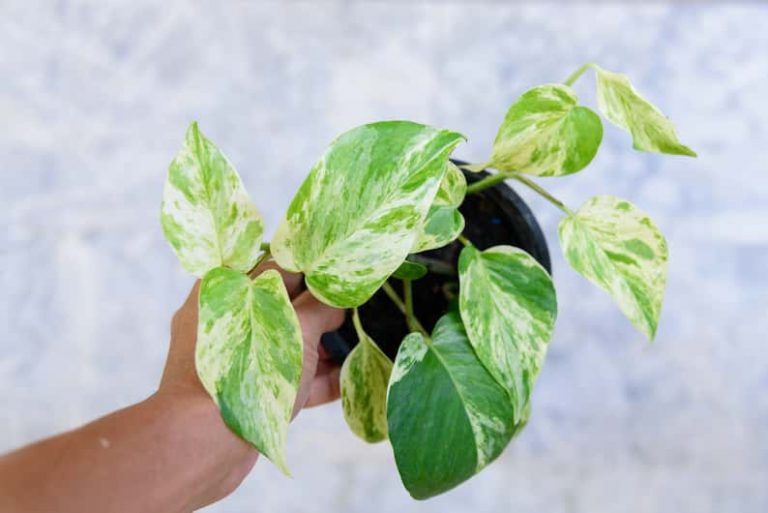
Marble Queen pothos plants are very common in the houseplant world. These lovely pothos plants have green leaves that are marked by white or cream variegation. The leaves are primarily green but are heavily speckled with marble-like patterns of white and cream, which is why you’ll often see people getting confused about the difference between the Snow Queen vs Marble Queen pothos.
This tropical vine originated in the jungles of French Polynesia. You can grow it outdoors as a ground cover in USDA zones 11 and 12 in the United States, but it makes a stunning and easy-care houseplant. It can be grown as a trailing pothos variety in a hanging basket, or it will also grow on a trellis or moss pole.
12. Brazil Pothos
Brazil pothos has a fun vibe to its appearance with dark green leaves marked by streaks of yellow and green. The name of the Brazil pothos came about because the coloration is quite similar to that of the flag of the nation of Brazil.
The Brazil pothos is frequently confused with the Brazil philodendron, which has a similar color pattern. These are not the same plant, despite their similar appearances and names. The Brazil pothos has thicker, bumpier leaves than the philodendron, and the leaves of the philodendron are more dramatically heart shaped than those of the Brazil pothos.
Find out more: Pothos vs Philodendron: 7 Key Differences to Tell Them Apart
13. Njoy Pothos
Njoy pothos is a cultivar of the familiar Marble Queen pothos plant. Njoy pothos has a vibrant green color with creamy white variegation that traces the outside rim of the leaves and streaks through the leaves. The variegation is large blotches instead of light speckles and patches of white on this pothos.
Njoy pothos is one of the smaller pothos plants and, for this reason, if space is at a premium in your home, the Njoy pothos would be a good choice. Njoy pothos only grow to about 6 to 9 inches tall and only creates vines that are about 10 feet long, as opposed to other pothos that grow up to 40 feet long.
14. Pearls And Jade Pothos
An inexpensive and easy to find variety of pothos, the Pearls and Jade variety is a smaller version of this lovely plant. This plant originated at the University of Florida by biologists who enjoyed tinkering with plant varieties. The Pearls and Jade pothos plant is created from a mutation of selected varieties of Marble Queen pothos plants.
Pearls and Jade pothos plants have streaky white variegation on a gray-green background. There is also usually some speckling of white on the green portions of the leaves of the Pearls and Jade plants. The leaves of the Pearls and Jade cultivar are on the smaller size, being about 3 inches long and 2 inches wide at the largest.
What’s the difference between the NJoy and Pearls and Jade Pothos?
The main difference between the Njoy and Pearls and Jade pothos is in the color and shape of their leaves. Njoy pothos have similar streaky variegation but not so many speckles in the green portion of the leaves. Additionally, Pearls and Jade pothos have narrower leaves than the broader Njoy pothos plants.
That said, you wouldn’t be blamed for asking the question as these two pothos types are easily confused because they look so similar.
15. Baltic Blue Pothos
If you are looking for an unusual pothos type for your indoor plant collection, the Baltic Blue pothos may be exactly what you are looking for. This version of the popular plant stands out as the most unusual and distinctive pothos plant. The Baltic Blue pothos plant features dark green leaves that look bluish as they mature, as well as developing fenestrations, giving them an unusual leaf shape.
When growing the Baltic Blue pothos plant, you should take care to give the plant the correct lighting conditions. If you give it too much light, the leaves will lose their bluish cast and simply look green. This pothos needs 4 to 6 hours of filtered light per day to keep the coloration what you want it to be.
What is the difference between Baltic Blue and Cebu Blue?
The main difference between the Baltic Blue and Cebu Blue pothos is their color. The Baltic Blue plant has leaves that are darker than the Cebu Blue plant, which has leaves that are more silvery. Also, the Baltic Blue pothos leaves will fenestrate earlier than the Cebu Blue plant.
Baltic Blue pothos are quite similar to Cebu Blue pothos, so the confusion between these two types of pothos is understandable, but once you see the plants side by side, you will notice the differences almost immediately.
16. Lemon Lime Pothos
Lemon Lime pothos is another name for the Neon pothos plant. Frequently confused with the Lemon Lime philodendron, the Lemon Lime pothos has cheery yellow green leaves.
The Lemon Lime philodendron has 7 to 10 inch leaves that curl inward slightly and the plant grows throughout the year. The Lemon Lime pothos plant, also called Neon pothos, has leaves that do not curl inward and only grows during the summer months.
17. Glacier Pothos
Glacier pothos are beautiful pothos plants with soft green leaves rimmed in creamy white. You’ll often see some confusion between the Glacier pothos vs Njoy pothos due to their similar appearances, with similarities with the Snow Queen pothos also often being a source of confusion for some.
However, here’s a good tip: the Glacier pothos has smaller, more rounded leaves than the Njoy and Snow Queen cultivars.
Also, the Glacier pothos plant has a slight silvery color separating the green from the white. The white patches are streaky rather than speckled or patchy as in the Njoy and Snow Queen plants.
18. Shangri La Pothos
Shangri La pothos plants have one of the most unusual appearances of all the pothos plants. This variety of pothos has dark green, oval shaped leaves that have an unusual crumpled or wrinkled appearance. The leaves generally remain somewhat curled up, even when they are mature.
Sometimes called the “Sleeping pothos” or the “Godzilla pothos”, the Shangri La pothos are rather rare and difficult to find. This variety was bred from the Golden pothos and has light green variegations on a dark green leaf.
19. Global Green Pothos
Global Green pothos is a newer variety of the classic pothos plant. The leaves of this plant are mid-green with darker green colors edging the leaves. Because the leaves have so much green coloration that generates energy from sunlight, the Global Green pothos plant grows much more quickly than many other pothos plants that have lots of white and light colored variegation on the leaves.
To keep the variegation prominent in the leaves, you should give the Global Green pothos plant the perfect lighting conditions. This plant should be grown within several feet of an east or west-facing window. Other than that, the Global Green pothos is just as easy to grow as the typical pothos plant.
20. Emerald Pothos
With subtle green on green variegation, the Emerald pothos plant may be a challenge to find. This plant has light green leaves with darker green blotches of color on the thick, glossy, heart-shaped leaves. Most of the variegation is in the center of the leaf.
The Emerald pothos plant and Global Green pothos plant are very similar. The main difference between the two plants is that the Emerald pothos variegation is less distinctive than that of the Global Green. On an Emerald pothos plant the variegation fades into the next color rather than being a bold line.
21. Silvery Ann Pothos
Silvery Ann is another name for the Silver pothos plant. This pothos variety is quite popular but sometimes can be hard to find. Silvery Ann pothos plants have silver-rimmed leaves with speckles of silvery white on the leaf surface.
The plants are easy to grow and can grow up to 1 meter tall as they twine up a vertical support.
What is the rarest pothos?
The most rare type of pothos is likely the Manjula version of this plant. This cultivar is fairly new to the market and it will take awhile for retailers and greenhouses to create enough plants to lower the price for the plants.
While pothos plants are generally considered inexpensive and easy to find, there are a few varieties that are rare. While Manjula may be the hardest pothos type to track down, there are a few other cultivars that are almost as difficult to find. For instance, the Jessenia pothos can be difficult to obtain, as well as the Harlequin and Emerald.
What is the most common type of pothos?
The top two easiest to find kinds of pothos plants are the Golden Pothos and the Marble Queen pothos. However, the most common pothos would be the Golden pothos. Neon pothos are also fairly easy to find in stores or online.
That said, there are various other types of pothos that are quite common in the houseplant world. Besides the few mentioned above that you won’t see every day, you should be able to find at least some different pothos varieties in most garden stores.
How do I identify pothos?
In general, the pothos plant has glossy, heart shaped leaves that grow on trailing vines. The leaves can feature differing kinds of variegation and often have a waxy texture to them. Usually, pothos plants have leaves that are rather bumpy and have a distinctive midrib running down the center of each leaf.
Pothos leaves are often asymmetrical and shaped a bit like a garden spade. Pothos plants put out new growth from current leaves, unfurling from the base of an existing leaf on the vine.
Are pothos and Devil’s Ivy the same thing?
Yes. Pothos is an easy to find, easy to care for houseplant that also grows wild in tropical areas of the world. This plant can manage to grow well when cared for by people who have the proverbial “black thumb.” Because it is so difficult to kill, some people have named the pothos plant “Devil’s Ivy.”
Pothos plants do not have special care needs. They do not need a ton of sunlight and can go for weeks without water. The only thing that will kill a pothos every single time is cold weather, since the tropical plants cannot stand even a touch of frost.
